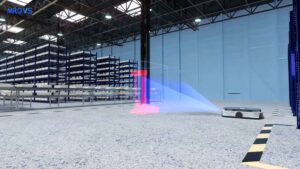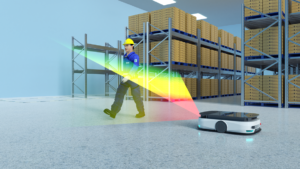Imagine a robot navigating through a busy warehouse, seamlessly avoiding obstacles like stacks of boxes, moving carts, and even other robots—all in real time. Now, picture that same robot doing it autonomously, without any human intervention. Sounds like science fiction? It’s not.
With the rise of robotic camera systems, mobile robots are now equipped with the advanced vision capabilities needed to safely and efficiently navigate complex environments. These systems are not only transforming the way robots perceive their surroundings but also redefining how they avoid obstacles in real time. In this blog, we’ll dive into how robotic camera systems are boosting
obstacle avoidance in robots, making them smarter, safer, and more efficient in everything from logistics to autonomous vehicles.
How Robotic Camera Systems Work in Mobile Robots
At the core of a mobile robot’s navigation lies its ability to perceive and understand its environment. Robotic camera systems play a crucial role in this, using sensors and algorithms to detect obstacles and help robots navigate safely. These systems give robots “vision,” enabling them to make real-time decisions for efficient movement.
-
Types of Robotic Camera Systems
-
RGB Cameras: Capture traditional 2D color images for object recognition, classification, and tracking.
-
RGB-D Cameras: Capture both color (RGB) and depth (D) information, creating 3D maps that help robots detect obstacles and judge distances accurately.
-
Depth Perception and 3D Mapping
Robotic camera systems use depth sensors like stereo vision or time-of-flight (ToF) to calculate distances to objects. By combining depth data with color images,
RGB-D cameras create detailed 3D maps, allowing robots to identify and avoid obstacles in complex spaces.
-
Real-Time Data Processing and Obstacle Detection
After capturing visual and depth data, the robot’s onboard computing system processes it to detect and classify obstacles. Real-time processing ensures that the robot can continuously scan, update its map, and make immediate decisions to avoid collisions.
-
Sensor Fusion and Decision-Making
Robotic camera systems often work with other sensors, such as LiDAR and IMUs, to provide a more accurate model of the environment. By combining visual data and precise distance measurements, the robot can make smarter, real-time decisions to avoid obstacles, even in dynamic settings.
Key Advantages of Robotic Camera Systems for Obstacle Avoidance
Robotic camera systems offer a range of key advantages that make them indispensable in improving obstacle avoidance for mobile robots. These advantages go beyond just detecting obstacles; they enhance the overall efficiency, safety, and intelligence of robots in complex environments. Here are some of the most notable benefits:
-
Enhanced Depth Perception: RGB-D cameras provide detailed depth information, allowing robots to perceive the distance of obstacles. This depth perception enables robots to adjust their speed or trajectory in real time, avoiding collisions by assessing the position of objects in their path.
-
Real-Time Data Processing: Robotic camera systems process data instantly, enabling robots to make quick decisions. This real-time processing ensures that the robot can avoid obstacles immediately upon detection, preventing delays that could lead to accidents or inefficient navigation.
-
High Precision and Accuracy: Robotic camera systems provide remarkable precision in detecting and identifying obstacles. Their ability to pinpoint the exact location, size, and shape of objects enables robots to navigate complex environments with minimal error, avoiding even small obstacles.
-
Adaptability to Complex Environments: These camera systems continuously update 3D maps and integrate data from multiple sensors, allowing robots to adapt to changing conditions. Whether it’s adjusting for new obstacles, sudden lighting changes, or moving objects, robotic camera systems ensure safe navigation in dynamic environments.
-
Ability to Detect Both Static and Dynamic Obstacles: Robotic cameras can distinguish between static obstacles (e.g., walls, furniture) and dynamic obstacles (e.g., humans, moving robots). This capability allows robots to adjust their movements accordingly, ensuring safe navigation even in busy or unpredictable environments.
-
Enhanced Object Recognition and Classification: Equipped with AI and machine learning algorithms, robotic camera systems can recognize and classify objects in the environment. This helps robots make informed decisions about how to handle obstacles, such as slowing down when approaching fragile items or avoiding moving humans.
-
Cost-Effectiveness and Efficiency: Compared to LiDAR systems, robotic camera systems offer a more affordable solution while still providing high-quality obstacle detection and avoidance. This cost-effectiveness makes them ideal for a variety of applications, from small-scale robots to large industrial robots.
-
Integration with Other Sensors for Comprehensive Coverage: Robotic camera systems work in tandem with other sensors like LiDAR, ultrasonic sensors, and IMUs to provide a more comprehensive environmental awareness. By combining data from various sensors, robots can make smarter, more accurate decisions in real-time, even in complex settings.

Applications of Robotic Camera Systems in Obstacle Avoidance
Robotic camera systems are being increasingly integrated into mobile robots across various industries to enhance obstacle avoidance. Here are some of the most impactful applications:
Warehouse Automation and Logistics
In modern warehouses, robots equipped with robotic camera systems are used to transport goods, sort inventory, and optimize storage. These robots need to navigate aisles filled with shelves, moving carts, and even other robots. By utilizing depth sensors and AI-powered cameras, they can detect obstacles in their path—whether static or moving—and avoid collisions, ensuring smooth and efficient operations. This reduces the risk of accidents and enhances productivity, allowing robots to work alongside human operators safely.
Autonomous Vehicles and Drones
Autonomous vehicles (
AVs) and drones rely heavily on robotic camera systems for obstacle avoidance in environments such as city streets, airports, or even rural landscapes. Cameras equipped with depth sensors allow these vehicles to detect pedestrians, other vehicles, traffic signs, and unexpected obstacles, helping them to navigate safely. Whether it’s a self-driving car steering clear of a pedestrian crossing the road or a drone avoiding power lines, robotic cameras provide crucial real-time data to make these decisions, improving the safety and reliability of autonomous systems.
Industrial Robotics in Manufacturing:
In manufacturing facilities, mobile robots are increasingly used for material handling, assembly, and inspection tasks. Robotic camera systems help these robots navigate through factory floors, avoiding obstacles such as machinery, workers, or other robots. In some cases, they also help robots interact with delicate items by detecting the objects’ shape and size. By accurately identifying obstacles in the robot’s path, camera systems ensure that these tasks are carried out efficiently and safely, preventing damage to products or equipment.
Agricultural Robotics
Agricultural robots, such as harvesters, need to navigate unpredictable environments filled with crops, trees, and varying terrains. Robotic camera systems provide the depth perception and object recognition required to avoid obstacles like tree branches, uneven ground, or even wildlife. This ability allows agricultural robots to work autonomously in fields, ensuring they can avoid potential hazards while performing tasks like harvesting, spraying, or planting crops with high precision and minimal disruption to the environment.
How MRDVS Camera Systems Enhance Obstacle Avoidance
MRDVS camera systems are designed to provide superior vision and depth perception for mobile robots, enhancing obstacle avoidance in dynamic environments. By integrating advanced RGB-D technology, real-time processing, and environmental sensing capabilities, MRDVS cameras enable robots to navigate safely and efficiently. Here’s how they improve obstacle avoidance:
-
High-Resolution RGB and Depth Sensing with Real-Time Processing
MRDVS cameras offer both high-resolution RGB and depth data, enabling precise detection of obstacles. The real-time processing of depth maps ensures that robots can quickly assess the size, shape, and distance of obstacles, allowing them to react immediately and avoid collisions with both small and large obstacles.
-
Wide Field of View and Fast Decision-Making
With a broad field of view (FOV), MRDVS cameras can detect obstacles from a greater distance, allowing robots to adjust their movement in advance. The system’s quick processing speed ensures that the robot can make decisions in real time, altering its path immediately upon detecting an obstacle to avoid potential collisions.
-
Compact, Lightweight Design with Robust Performance
The compact and lightweight design of MRDVS cameras makes them easy to integrate into mobile robots without compromising on performance. This design allows for greater maneuverability, particularly in tight or cluttered spaces. Despite the small form factor, the cameras maintain robust obstacle detection capabilities in various environmental conditions.
-
Advanced Sensor Fusion for Enhanced Environmental Awareness
MRDVS cameras integrate seamlessly with other sensors like LiDAR, ultrasonic sensors, and IMUs, creating a more accurate and reliable environmental map. This sensor fusion provides comprehensive coverage for obstacle detection, allowing robots to make smarter decisions and navigate more safely in complex environments.
-
AI-Powered Object Detection for Smarter Navigation
Equipped with AI-driven object detection algorithms, MRDVS cameras can identify and classify obstacles, distinguishing between static and dynamic objects. This advanced detection helps robots make informed decisions, adjusting their path based on the type of obstacle and optimizing their movement for maximum safety and efficiency.
Conclusion
Robotic camera systems are at the forefront of enabling mobile robots to navigate complex and dynamic environments safely and efficiently. By providing high-resolution depth perception, real-time data processing, and enhanced decision-making capabilities, these systems allow robots to detect and avoid obstacles with impressive accuracy. Whether in warehouses, autonomous vehicles, or healthcare settings, the integration of robotic camera systems significantly improves a robot’s ability to navigate without collisions. As technology continues to advance, the role of these systems in obstacle avoidance will only become more critical, pushing the boundaries of autonomy and paving the way for smarter, more reliable robots in a variety of industries.


